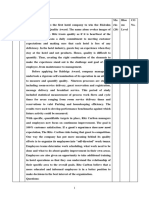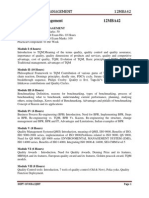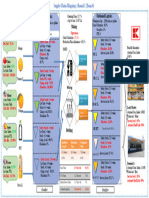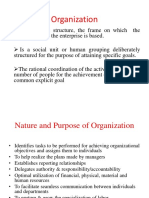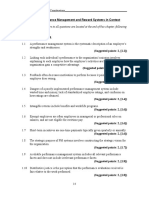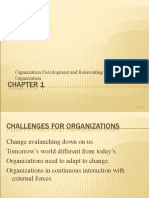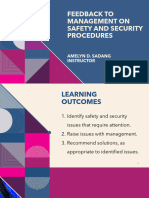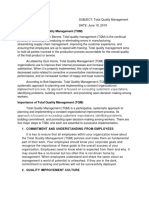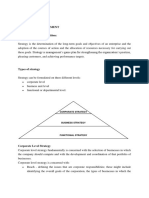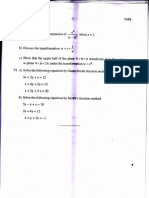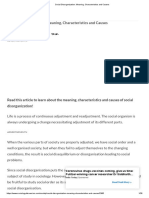100%(1)100% found this document useful (1 vote)
675 viewsIE488 Total Quality Management
IE488 Total Quality Management
Uploaded by
Praveen H Praveen HThis document outlines the course objectives, syllabus, expected outcomes, references, and course plan for the Total Quality Management course (IE488). The course is a 3 credit hour course introduced in 2016. The objectives are to impart knowledge of TQM principles and practices to achieve quality, enable the use of TQM tools for continuous improvement, and provide ideas on implementing quality standards. The syllabus covers topics such as quality control tools, cost of quality, TQM frameworks, six sigma, failure mode analysis, and quality standards. Upon completing the course, students are expected to understand TQM principles and practices, use TQM tools for improvement, implement quality standards, and learn about latest TQM techniques. The course plan outlines the topics
Copyright:
© All Rights Reserved
Available Formats
Download as PDF, TXT or read online from Scribd
IE488 Total Quality Management
IE488 Total Quality Management
Uploaded by
Praveen H Praveen H100%(1)100% found this document useful (1 vote)
675 views2 pagesThis document outlines the course objectives, syllabus, expected outcomes, references, and course plan for the Total Quality Management course (IE488). The course is a 3 credit hour course introduced in 2016. The objectives are to impart knowledge of TQM principles and practices to achieve quality, enable the use of TQM tools for continuous improvement, and provide ideas on implementing quality standards. The syllabus covers topics such as quality control tools, cost of quality, TQM frameworks, six sigma, failure mode analysis, and quality standards. Upon completing the course, students are expected to understand TQM principles and practices, use TQM tools for improvement, implement quality standards, and learn about latest TQM techniques. The course plan outlines the topics
Original Description:
TQM KTU SYLLABUS
Copyright
© © All Rights Reserved
Available Formats
PDF, TXT or read online from Scribd
Share this document
Did you find this document useful?
Is this content inappropriate?
This document outlines the course objectives, syllabus, expected outcomes, references, and course plan for the Total Quality Management course (IE488). The course is a 3 credit hour course introduced in 2016. The objectives are to impart knowledge of TQM principles and practices to achieve quality, enable the use of TQM tools for continuous improvement, and provide ideas on implementing quality standards. The syllabus covers topics such as quality control tools, cost of quality, TQM frameworks, six sigma, failure mode analysis, and quality standards. Upon completing the course, students are expected to understand TQM principles and practices, use TQM tools for improvement, implement quality standards, and learn about latest TQM techniques. The course plan outlines the topics
Copyright:
© All Rights Reserved
Available Formats
Download as PDF, TXT or read online from Scribd
Download as pdf or txt
100%(1)100% found this document useful (1 vote)
675 views2 pagesIE488 Total Quality Management
IE488 Total Quality Management
Uploaded by
Praveen H Praveen HThis document outlines the course objectives, syllabus, expected outcomes, references, and course plan for the Total Quality Management course (IE488). The course is a 3 credit hour course introduced in 2016. The objectives are to impart knowledge of TQM principles and practices to achieve quality, enable the use of TQM tools for continuous improvement, and provide ideas on implementing quality standards. The syllabus covers topics such as quality control tools, cost of quality, TQM frameworks, six sigma, failure mode analysis, and quality standards. Upon completing the course, students are expected to understand TQM principles and practices, use TQM tools for improvement, implement quality standards, and learn about latest TQM techniques. The course plan outlines the topics
Copyright:
© All Rights Reserved
Available Formats
Download as PDF, TXT or read online from Scribd
Download as pdf or txt
You are on page 1of 2
Course Course Name L-T-P - Year of
code Credits Introduction
IE488 TOTAL QUALITY MANAGEMENT 3-0-0-3 2016
Prerequisite : Nil
Course Objectives:
To impart knowledge on principles and practices of TQM to achieve quality.
To enable use of TQM tools for continuous quality improvement.
To provide ideas on implementation of quality standards.
To introduce the latest TQM tools and techniques.
Syllabus:
Introduction to quality, Contributions of quality Gurus, Q uality control tools, Cost
of Quality, Taguchi loss function, Basic concepts of TQM, P rinciples of Total
Quality Management, Total quality control, Quality assurance, Vendor rating,
Quality improvement programmes, Quality planning, Quality function deployment,
Six sigma approach, Failure mode & effect analysis, TPM, BPR , Quality standards.
Expected outcome.
The students will be able to
i. Understand the principles and practices of TQM.
ii. Use various TQM tools for continuous quality improvement.
iii. Implement quality standards.
iv. Become aware of the latest TQM tools and techniques.
References:
1. Sharma D D, Total Quality Management, Sultan Chand & Sons, 2014
2. R.P. Mohanty & R R Lakhi, Total Quality Management, Jaico Pub, New
Delhi, 1994
3. Poornima M.Charantimath , Total Quality Management, Pearson Education,
2011.
4. Lon Roberts , Process Re-Engineering , Tata McGraw Hill, New Delhi, 1994
5. Mohamed Zairi , TQM for Engineers , Gulf Pub. Co., 2nd Edition, New
Delhi.
Course Plan
End
Sem.
Module Contents Hours Exam
Marks
Introduction-Need for quality, Definition of quality,
Major contributions of Deming, Juran and Crossby to 15%
I 7
Quality Management, Q uality control tools, Cost of
Quality, Taguchi loss function.
Basic concepts of Total Quality Management -
Evolution of TQM, TQM framework, Barriers to TQM, 15%
II 7
P rinciples of Total Quality Management- Quality
statements, Customer focus, Customer orientation,
Customer satisfaction, Customer complaints, Customer
retention, Total quality control, total waste
elimination, total employee involvement.
FIRST INTERNAL EXAMINATION
Quality assurance- Total quality assurance,
Management principles in quality assurance,
O bjectives of quality assurance system, H ierarchical
III 7 15%
planning for Quality Assurance, Vendor rating,
Quality improvement: elements, programmes –
KAIZEN, PDCA cycle,5S, Quality circles.
Quality planning- SWOT analysis, Strategic
planning, strategic grid, organizational culture, Total
IV Quality Culture, Quality function deployment- QFD 7 15%
concept, the voice of customer, developing a QFD
matrix, QFD process.
SECOND INTERNAL EXAMINATION
Six sigma approach–Me t h o d o l o g y , T r a i n i n g ,
V a p p l i c a t i o n to various industrial situations, Failure mode 7 20%
& effect analysis- Concepts, Types & Applications in TQM.
TPM–Concepts, Improvement needs, Performance
measures, BPR, Quality standards – Need of
VI standardization, ISO 9000 series, ISO 14000 series, 7 20%
Other contemporary standards.
END SEMESTER EXAM
Question Paper Pattern:
Examination duration: 3 hours Maximum Marks: 100
Part A (Modules I and II):
Candidates have to answer any 2 questions from a choice of 3 questions. Each full
question carries a total of 15 marks and can have a maximum of 4 sub questions (a, b, c,
d). No two f u l l questions shall be exclusively from a single module. All three questions
shall preferably have components from both modules. Marks for each question/sub
question shall be clearly specified. Total percentage of marks for the two modules put
together as specified in the curriculum shall be adhered to for all combinations of any
two questions.
Part B (Modules III and IV): (Same as for part A marks)
Part C (Modules V and VI): (Same as for part A, except that each full question carries 20
marks)
Note: If use of tables and charts are permitted for the university examination for this
course, proper direction of the same should be provided on the facing sheet of the
question paper.
You might also like
- PNU ProfED JWRADocument244 pagesPNU ProfED JWRACharlotte AntonioNo ratings yet
- Managing Quality (1) PPT SlidesDocument69 pagesManaging Quality (1) PPT Slidesdiana valdezNo ratings yet
- Implementation of TQM in A Manufacturing Organization Case Study 1Document4 pagesImplementation of TQM in A Manufacturing Organization Case Study 1Ahtsham MughalNo ratings yet
- Chapter 9 Inventory FundamentalsDocument5 pagesChapter 9 Inventory FundamentalsKamble Abhijit100% (1)
- TQM Case StudyDocument2 pagesTQM Case StudyVaishnavi khotNo ratings yet
- English Lesson Plan 2017Document2 pagesEnglish Lesson Plan 2017FY Chieng100% (3)
- Recognition Day ScriptDocument6 pagesRecognition Day ScriptKemberly Semaña Penton100% (2)
- Mba IV Total Quality Management (12mba42) NotesDocument113 pagesMba IV Total Quality Management (12mba42) NotesPradeep GsNo ratings yet
- Training EvaluationDocument41 pagesTraining EvaluationLordannie John LanzoNo ratings yet
- Student Peer Evaluation Sheet FinalDocument2 pagesStudent Peer Evaluation Sheet Finalapi-346999242No ratings yet
- Supply Chain Map-1Document1 pageSupply Chain Map-1deepak devassiaNo ratings yet
- Imp of Leadership in TQMDocument18 pagesImp of Leadership in TQMAsim AbbasiNo ratings yet
- 1 - Organizations and Organization TheoryDocument27 pages1 - Organizations and Organization TheoryantialonsoNo ratings yet
- Marketing Kotler&Amstrong CHP 9Document23 pagesMarketing Kotler&Amstrong CHP 9sejin cho100% (1)
- Lesson 1-Macro Perspective in Tourism and HospitalityDocument8 pagesLesson 1-Macro Perspective in Tourism and HospitalityAngelica LozadaNo ratings yet
- TQM Operations ManagementDocument12 pagesTQM Operations ManagementMuhammad Sajid Saeed100% (2)
- Syllabus Ap-Microeconomics-Sample 1 1058788v1Document4 pagesSyllabus Ap-Microeconomics-Sample 1 1058788v1api-359133069No ratings yet
- Xrobbins Eob10 Basic PPT Ch01Document21 pagesXrobbins Eob10 Basic PPT Ch01whatme23100% (1)
- 6 - Introduction To Total Quality ManagementDocument68 pages6 - Introduction To Total Quality ManagementAYAME MALINAO BSA19No ratings yet
- American College of Technology: Marketing Research and IntelligenceDocument40 pagesAmerican College of Technology: Marketing Research and IntelligenceTekta MideksaNo ratings yet
- PM 0017-Project Quality ManagementDocument10 pagesPM 0017-Project Quality ManagementNick SinNo ratings yet
- Effects of Restaurant Green Practices Which PractiDocument24 pagesEffects of Restaurant Green Practices Which PractiKabir GandhiNo ratings yet
- Chapter (Three) Job Analysis and Job Design: Basic TerminologyDocument13 pagesChapter (Three) Job Analysis and Job Design: Basic TerminologyMukteswar Das NickyNo ratings yet
- Operations Management ReportDocument54 pagesOperations Management ReportMj GutierrezNo ratings yet
- Unit 2 Organization and StaffingDocument103 pagesUnit 2 Organization and StaffingNaveena mNo ratings yet
- Course Objectives: MGT 412 Strategic ManagementDocument2 pagesCourse Objectives: MGT 412 Strategic ManagementJoshan PradhanNo ratings yet
- Safety and SecurityDocument2 pagesSafety and SecurityRusheen CunninghamNo ratings yet
- Consumer BehaviourDocument68 pagesConsumer Behaviourrenu90100% (1)
- Chapter-Two: Competitiveness, Strategies, and Productivity in OperationsDocument63 pagesChapter-Two: Competitiveness, Strategies, and Productivity in OperationsChernet AyenewNo ratings yet
- Chapter 5, Human Resource Development and ManagementDocument33 pagesChapter 5, Human Resource Development and ManagementRameez Ramzan Ali100% (2)
- Operations Management ComprehensiveDocument9 pagesOperations Management ComprehensiveashishNo ratings yet
- Ethics in FinanceDocument9 pagesEthics in FinanceSunu RupeshNo ratings yet
- Global MarketingDocument21 pagesGlobal MarketingDurva Sawant100% (1)
- Basic Business Finance 07Document8 pagesBasic Business Finance 07knockdwnNo ratings yet
- Module 7 in Operation ManagementDocument12 pagesModule 7 in Operation ManagementMaricar Tan ArtuzNo ratings yet
- Aguinis - Performance Management 3eDocument15 pagesAguinis - Performance Management 3eMega Pop LockerNo ratings yet
- Heizer Chapter 6 - Managing QualityDocument17 pagesHeizer Chapter 6 - Managing QualityANo ratings yet
- Organization Development and Reinventing The Organization: 1 Slide 1Document38 pagesOrganization Development and Reinventing The Organization: 1 Slide 1Snehal Sunil Darji100% (1)
- Business EthicsDocument3 pagesBusiness EthicsAshika JayaweeraNo ratings yet
- Quality Function Deployment: by Zaipul Anwar Business & Advanced Technology Centre, Universiti Teknologi MalaysiaDocument33 pagesQuality Function Deployment: by Zaipul Anwar Business & Advanced Technology Centre, Universiti Teknologi MalaysiaRian JanuarsyahNo ratings yet
- Handout Topic 1 Introduction To Operations ManagementDocument56 pagesHandout Topic 1 Introduction To Operations Managementaisyahphilips100% (1)
- Strama Quiz 9Document2 pagesStrama Quiz 9Yi ZaraNo ratings yet
- Introducing Organizational BehaviorDocument30 pagesIntroducing Organizational BehaviorOvaIs MoInNo ratings yet
- L7 Feedback To Management On Safety and Security ProceduresDocument20 pagesL7 Feedback To Management On Safety and Security ProceduresprincessbernadethcabalticanNo ratings yet
- TQMDocument3 pagesTQMArlyn Ramirez IINo ratings yet
- Business Ethics, Stakeholder ManagementDocument17 pagesBusiness Ethics, Stakeholder ManagementRempeyekNo ratings yet
- CHAPTER 6 Online QuizDocument12 pagesCHAPTER 6 Online Quizေဟ မိုးဆက္No ratings yet
- Quality GurusDocument10 pagesQuality GurusKhidir HamidNo ratings yet
- La Consolacion University Philippines: (Formerly University of Regina Carmeli) Catmon, City of MalolosDocument6 pagesLa Consolacion University Philippines: (Formerly University of Regina Carmeli) Catmon, City of MalolosMacky TeopeNo ratings yet
- Ergonomics Module IDocument26 pagesErgonomics Module ILayna AcostaNo ratings yet
- ASSIGNMENT No. 1 Course: Total Quality Management (890) Semester: SpringDocument10 pagesASSIGNMENT No. 1 Course: Total Quality Management (890) Semester: SpringNadir Shah76% (17)
- Global MarketingDocument22 pagesGlobal MarketingRaajjj86% (7)
- International Management JournalsDocument23 pagesInternational Management JournalsNathanael Albert Widyanto100% (1)
- Unit 1 SM NOTESDocument17 pagesUnit 1 SM NOTES6038 Mugilan kNo ratings yet
- Operations Management and TQMDocument3 pagesOperations Management and TQMMichelleNo ratings yet
- Managerial FunctionsDocument15 pagesManagerial FunctionsbomasitaNo ratings yet
- 1-Introduction To Marketing ResearchDocument35 pages1-Introduction To Marketing ResearchShoaib ImtiazNo ratings yet
- M1.Intro To Hospitality 1Document8 pagesM1.Intro To Hospitality 1Maribelle JojoNo ratings yet
- 1 Introduction - HRMDocument23 pages1 Introduction - HRMdhrupaNo ratings yet
- Madhu ... Kotler PPT ..PowerpointDocument18 pagesMadhu ... Kotler PPT ..PowerpointMadhuri SinghviNo ratings yet
- Value Chain Management Capability A Complete Guide - 2020 EditionFrom EverandValue Chain Management Capability A Complete Guide - 2020 EditionNo ratings yet
- IC364 Total Quality ManagementDocument2 pagesIC364 Total Quality ManagementAKSHAY KRISHNA K RNo ratings yet
- TQM SyllabusDocument4 pagesTQM SyllabusMazumder Suman100% (1)
- Malvern Particle Size AnalyzerDocument2 pagesMalvern Particle Size AnalyzerPraveen H Praveen HNo ratings yet
- Phase Doppler Particle AnalyzerDocument3 pagesPhase Doppler Particle AnalyzerPraveen H Praveen HNo ratings yet
- Maths - Feb 2011 p-3Document1 pageMaths - Feb 2011 p-3Praveen H Praveen HNo ratings yet
- Maths March 2010 p1Document1 pageMaths March 2010 p1Praveen H Praveen HNo ratings yet
- Maths - Feb 2011 p-2Document1 pageMaths - Feb 2011 p-2Praveen H Praveen HNo ratings yet
- Introduction To Sustainable EnggDocument4 pagesIntroduction To Sustainable EnggPraveen H Praveen HNo ratings yet
- Academic RegDocument2 pagesAcademic RegPraveen H Praveen HNo ratings yet
- Gazette Date: 15/06/2012 Last Date: 19/07/2012 Category No: 295/2012Document2 pagesGazette Date: 15/06/2012 Last Date: 19/07/2012 Category No: 295/2012Praveen H Praveen HNo ratings yet
- Combustion Modelling of Normal Butanol in Hcci EngineDocument31 pagesCombustion Modelling of Normal Butanol in Hcci EnginePraveen H Praveen HNo ratings yet
- Thrust Measurement of Dimethyl Ether Arcjet ThrusterDocument24 pagesThrust Measurement of Dimethyl Ether Arcjet ThrusterPraveen H Praveen HNo ratings yet
- Test-20.01.21 13.30Document18 pagesTest-20.01.21 13.30Vidushee JeerakunNo ratings yet
- Efectos en La Desintegración Familiar en InglésDocument104 pagesEfectos en La Desintegración Familiar en InglésNelson LopezNo ratings yet
- Agriculture 3rd QuarterDocument17 pagesAgriculture 3rd QuarterRHNo ratings yet
- Nursing Diagnosis 3Document2 pagesNursing Diagnosis 3Mark Cau Meran100% (2)
- (L3) - (JLD 3.0) - Haloalkane & Haloarenes - 08 SeptDocument47 pages(L3) - (JLD 3.0) - Haloalkane & Haloarenes - 08 Septfunnyvideos. comNo ratings yet
- VITEEE 2024 Information BrochureDocument20 pagesVITEEE 2024 Information BrochureIgnatius IgnatiusNo ratings yet
- K Tran ResumeDocument1 pageK Tran Resumeapi-290595948No ratings yet
- Developing Smart Meter: A Project PlanDocument16 pagesDeveloping Smart Meter: A Project PlanJitendra MalikNo ratings yet
- Job VacancyDocument10 pagesJob VacancyRiski AmandaNo ratings yet
- Typology of Learning DisabilitiesDocument29 pagesTypology of Learning DisabilitiesFloieh Quindara100% (1)
- 04 Models For Understanding I.P. RelationshipsDocument16 pages04 Models For Understanding I.P. RelationshipsanikethroyNo ratings yet
- Btech New PuneDocument2 pagesBtech New PunerichashyampatilNo ratings yet
- Adjunct Professor ResumeDocument8 pagesAdjunct Professor Resumegvoimsvcf100% (2)
- 7 Best Clubs of FA Community Shield On TVDocument4 pages7 Best Clubs of FA Community Shield On TVpriyankaNo ratings yet
- College Essay Essentials Final SJP 2024Document54 pagesCollege Essay Essentials Final SJP 2024api-26003930No ratings yet
- Kryterion Testing Network Quick Reference and Troubleshooting GuideDocument1 pageKryterion Testing Network Quick Reference and Troubleshooting Guidesestidavide.mailNo ratings yet
- Population Welfare Department, Directorate of Population WelfareDocument2 pagesPopulation Welfare Department, Directorate of Population Welfareامین ثانیNo ratings yet
- Luo Qianlin: Personal Personal Details Details Educational Educational Background BackgroundDocument2 pagesLuo Qianlin: Personal Personal Details Details Educational Educational Background Backgroundapi-560144507No ratings yet
- Martin Heidegger and Meister Eckhart - Dalle Pezze, Barbara (2008) (Grayscale OCR)Document212 pagesMartin Heidegger and Meister Eckhart - Dalle Pezze, Barbara (2008) (Grayscale OCR)MissJaieEmm100% (5)
- Multiple Choice Questions (MCQ) On Principles and Practices of Management (PPM) - Page 2 of 4 - ScholarexpressDocument3 pagesMultiple Choice Questions (MCQ) On Principles and Practices of Management (PPM) - Page 2 of 4 - ScholarexpressZaki AziziNo ratings yet
- Class Vi Jawahar Navodaya Vidyalaya Selection Test - 2021Document2 pagesClass Vi Jawahar Navodaya Vidyalaya Selection Test - 2021Devender SharmaNo ratings yet
- PhonicDocument41 pagesPhonicAnusuya RamasamyNo ratings yet
- Social Disorganization - Meaning, Characteristics and CausesDocument25 pagesSocial Disorganization - Meaning, Characteristics and CausesktkiNo ratings yet
- Practicals in PsychologyDocument5 pagesPracticals in PsychologyabraraslamqureshiNo ratings yet
- Communication and Consumer BehaviorDocument25 pagesCommunication and Consumer BehaviorimadNo ratings yet
- Reres Nur Fitriana 19420050 TranslationDocument2 pagesReres Nur Fitriana 19420050 TranslationDwiindah ptrNo ratings yet
- APA Formatting & StyleDocument39 pagesAPA Formatting & StyleEdward GanNo ratings yet




